NinjaOne is a popular and solid remote monitoring and management (RMM) platform, but it won’t fit every workflow perfectly. For example, it lacks graphical support for Linux and comprehensive business intelligence reports, which might lead you to wonder: What companies are competitors of NinjaOne?
Well, finding the right NinjaOne alternative for your business isn’t straightforward, primarily because the market is crowded with options that differ widely in features, user interface design, and pricing.
In this article, we evaluate the best ten NinjaOne alternatives as of 2026.
But first, let’s explore the NinjaOne platform itself.
What is NinjaOne?
NinjaOne is a cloud-based software-as-a-service (SaaS) remote monitoring and management (RMM) platform for controlling a large number of IT devices and systems in business settings. It combines several capabilities that help enforce consistent operational and security standards:
- Remote monitoring and management (RMM) to monitor device status, track hardware specifications and performance metrics, check contract details, and apply technical policies across endpoints.
- Mobile device management (MDM) to control Apple and Android mobile operating systems, as well as locate and remotely wipe lost devices.
- Network monitoring to discover and monitor SNMP-capable devices, such as routers, switches, printers, and other access points.
- Patch management across operating systems and a wide catalog of third-party applications.
- Automation and scripting for scheduled, on-demand, and event-triggered IT tasks.
- Help desk and ticketing to troubleshoot issues.
- Backup and restoration to protect critical data on storage platforms.
- Security, such as multi-factor authentication, role-based access controls, and audit logs.
- Platform integration with service desk tools, security software, authorization and identity management services, and other remote access tools.
NinjaOne offers custom pricing based on the number of endpoints under management, with discounts at scale.
Who uses NinjaOne?
NinjaOne replaces a patchwork of tools with a single, compliant platform for organizations across industries, typically including:
- Managed service providers (MSPs) that run multitenant operations, monitor and patch endpoints for client organizations, handle support tickets, and provide remote support.
- Internal IT teams that need to automate device and policy management for a blend of Windows, macOS, Linux, and mobile devices.
- Healthcare, financial, legal, and public organizations that need auditable records of remote sessions, tight security, regulation-compliant privacy controls (SOC 2, HIPAA, GDPR, etc.).
Let's take a closer look at the platform to see why it might or might not fit your business needs.
Pros and Cons of Using NinjaOne
NinjaOne helps manage operational complexity, but, like any platform, some design choices result in functionality gaps.
Pros of NinjaOne
- Consolidated systems. NinjaOne eliminates the need for separate RMM, patching, backup, MDM, and help desk tools for your systems. It reduces licensing costs, integration overhead, and maintenance complexity.
- Remote access. It can launch fully recorded remote sessions on user devices to create an audit trail, which is helpful for IT operations teams and MSPs that need to serve dozens of clients daily.
- Compliance posture. NinjaOne publishes SOC 2 Type II reports and implements security practices like role-based access control, audit logging, and multifactor authentication.
- Productivity gains. IT administrators can implement security updates for Windows, macOS, Linux, as well as multiple business applications from a single platform, avoiding blind spots that happen when patching tools are fragmented.
- Transparent tiering and trial. Pricing is per-endpoint tier, with discounts at scale. A 14-day trial gives time to test NinjaOne’s features before buying.
Cons of NinjaOne
- Template reports. NinjaOne’s reporting is template-driven, so creating unique, one-off analytics summaries requires exporting data to business intelligence (BI) tools.
- Confusing patch views. Distinguishing pending versus failed states and filtering for date or device group is challenging when managing devices at scale.
- No graphical interface for Linux. Its Linux agent has a command-line remote terminal, but no point-and-click desktop controls.
- Lacks ARM support. Without ARM support for Linux, you’ll need other tools to monitor some devices (like Raspberry Pi).
- Complex tenant structure. It can be difficult to arrange complex client or site hierarchies and enroll offline devices during setup.
Given its strengths and weaknesses, it’s understandable that companies seek an alternative platform.
Why Businesses Look for NinjaOne Alternatives?
NinjaOne is a staple for many IT teams, but its limitations make it a poor fit for some organizations. Here are some of the primary reasons businesses look for alternatives:
- NinjaOne gives volume discounts, but add-ons can accumulate, meaning very large fleets can see total cost rise. Some organizations prefer the flat or user-based pricing offered by other platforms to plan their budgets.
- Smaller teams that don’t qualify for volume discounts pay more per endpoint.
- IT leaders who want highly customized, cross-object analytics or sleek visuals seek alternatives that don’t require exporting data to third-party tools.
- Because it lacks ARM support, teams that require native graphical remote control for Linux desktops seek out NinjaOne competitors.
- NinjaOne’s built-in scripting features, while capable, can be too basic for organizations that standardize on code review, secrets handling, and versioning across many scripts.
- IT staff sometimes need richer mobile-first remote management capabilities (such as document access during site visits) than NinjaOne offers.
Different teams demand asset management and monitoring software with tools specific to their business priorities in their asset management and monitoring software. Luckily, in 2026, the market has a range of options for them.
Top 10 NinjaOne Alternatives for IT Management in 2026
Here are ten platforms, each serving as a viable NinjaOne alternative with distinct features, advantages, and limitations.
1. ConnectWise Automate
ConnectWise Automate (formerly LabTech) is a long-standing RMM platform designed mainly for MSPs with a focus on granular scripting, deep visibility into endpoints, and integration with the broader ConnectWise ecosystem (billing, quoting, service operations, etc.).
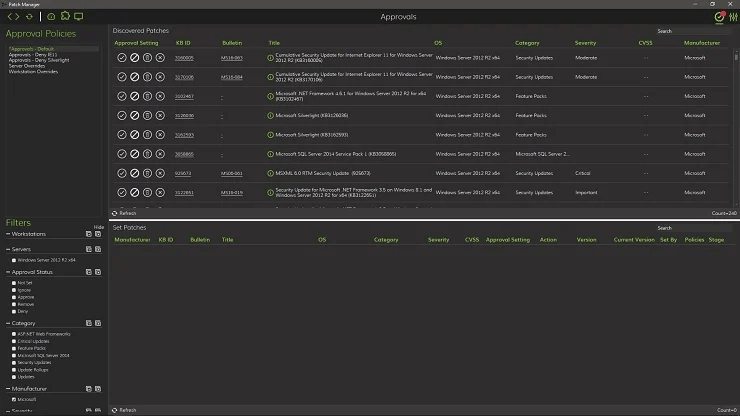
Features:
- Comprehensive RMM for Windows and partial macOS/Linux support for monitoring, patching, and alerts.
- Advanced scripting: Store, customize, and schedule scripts for large-scale deployment.
- Integrations with the ConnectWise ecosystem, including Manage, Control, and Sellapps.
- Asset tracing for hardware and software inventory.
- ScreenConnect remote control with recording for troubleshooting.
- Optional built-in MSP help desk.
Pros
Combines technical management and business operations in one platform.
Scalable scripting reduces technical effort.
Detailed system data with granular insights for proactive support and planning.
Deployable on-premises and in the cloud.
Large partner network and forums share resources and expertise.
Cons
Initial setup is not beginner-friendly; it often requires specialized expertise or a professional services agreement.
Mac and Linux features lag behind development of Windows features.
Slightly outdated console that’s harder to get around than other NinjaOne competitors.
Additional pricing for different add-ons can increase cost significantly.
2. Ivanti
Ivanti, known for its Neurons platform for unified endpoint management (UEM) and Mobile Device Management (MDM), targets enterprises managing large, distributed workforces. It a good fit for organizations with thousands of devices, branch offices, or heavy compliance demands. It requires more expertise to configure and maintain than some competitors.

Features:
- Real-time, unified endpoint management and automated threat response for Windows, macOS, Linux, iOS, and Android.
- Real-time endpoint monitoring with automated responses to threats.
- Patch deployment scheduling and policy enforcement.
- Built-in vulnerability management with CVE data and risk scoring.
- Mobile device management with app controls, kiosk modes, and remote wipe.
- Automation bots that allow custom workflows for routine tasks.
Pros
Manages large device fleets efficiently across many locations.
Bots and custom workflows speed up repetitive work.
Vulnerability scanning, risk prioritization, and automated patching to improve security posture.
MobileIron integration extends strong app deployment, security enforcement, and mobile workforce protection.
On-premises and cloud deployment options.
Cons
Requires skilled administrators for customization and ongoing maintenance.
Reporting and service management interfaces feel slow.
Limited support for newer Android and Windows capabilities.
Inconsistent support quality and difficulty resolving technical bugs.
Per-device licensing can become expensive for midsized companies.
3. SolarWinds
SolarWinds is an IT operations management and monitoring platform that excels in real-time visibility of networks, servers, and applications. It’s widely used in enterprises and government agencies that prioritize reliability, traffic analytics, and uptime.
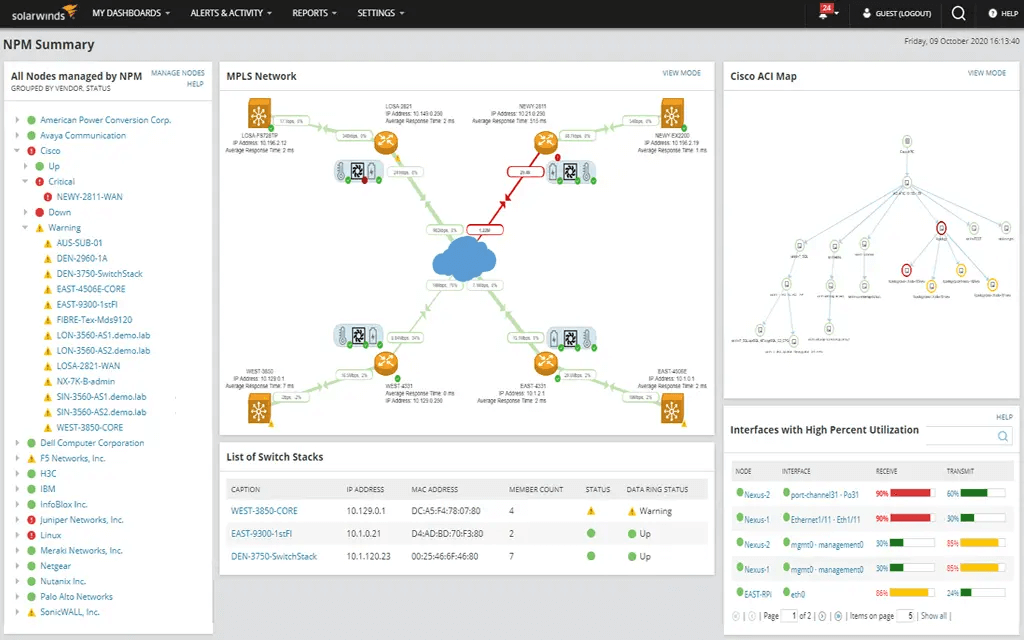
Features:
- Network Performance Monitor and NetFlow Analyzer track traffic, bandwidth, and application health.
- Patch management, access controls, and threat detection modules.
- Performance tracking for SQL Server, Oracle, and virtualization systems.
- Works with ServiceNow, AWS, OneLogin, and Zapier, though it offers fewer integration options than NinjaOne.
Pros
Network monitoring and performance analytics with granular visibility.
Designed for midsized and large organizations, as well as public sector environments with strict operational requirements.
A user community (called THWACK) shares troubleshooting tips, script libraries, and best practices.
Ticketing and ITIL-aligned processes built into the Service Desk.
Cons
The console looks dated and requires advanced skills to configure.
The company’s reputation was hurt after a 2020 Orion breach that exploited a Solar Wind vulnerability.
Long ticket resolution times for complex issues.
Full coverage can require buying and maintaining multiple SolarWinds modules, which increases cost.
4. ManageEngine Endpoint Central
ManageEngine Endpoint Central is a UEM platform that combines patching, remote support, MDM, and asset control. It’s one of the best NinjaOne alternatives for enterprises in regulated industries with large, distributed device fleets.
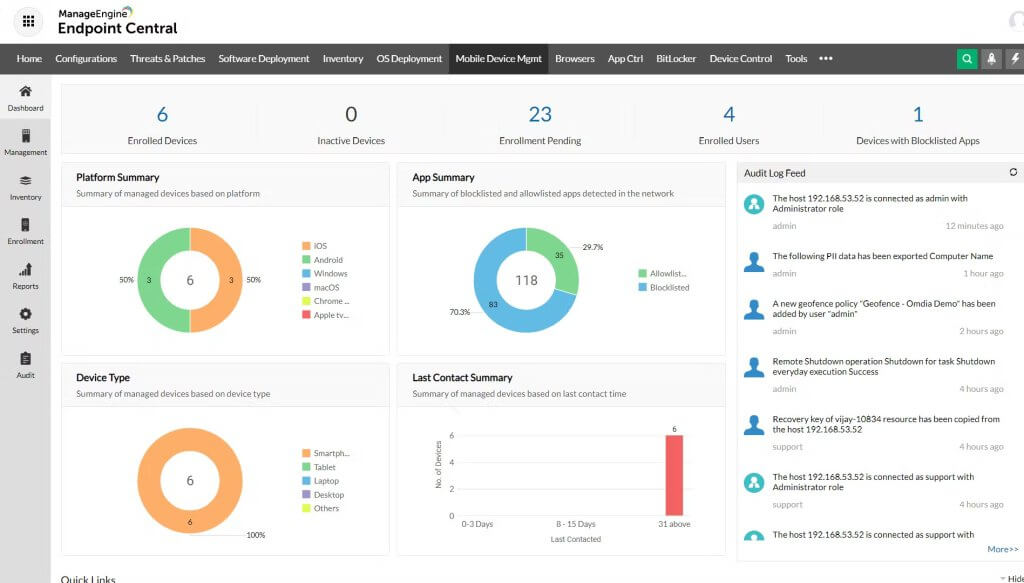
Features:
- Automated deployment of OS and third-party app updates with compliance reporting.
- Remote file manager, task manager, registry editing, and desktop control.
- Asset and license tracking to monitor hardware and software usage.
- MDM for both company-owned and bring your own devices (BYODs).
Pros
All-in-one functionality reduces the need for multiple tools.
Scheduling and compliance visibility simplify patch management.
Allows IT admins to resolve endpoint issues without VPN access, which is valuable for hybrid and remote workforces.
Connects with Active Directory, Google Workspace, and other IT management tools.
Works for small businesses with under 100 devices as well as enterprises managing thousands of endpoints.
Cons
Setup, customization, and performance tuning require more technical resources than other NinjaOne competitors.
The AI agent can consume significant device resources, slowing endpoints during intensive tasks like patch deployment.
Some modules have a dated design that loads slowly on large datasets.
macOS and Linux management options are less developed than Windows versions.
5. Syncro
Syncro is a NinjaOne alternative oriented towards MSPs and IT admins who want RMM, PSA, and billing tools in one subscription. The platform charges per technician, making it appealing to smaller MSPs managing many devices.
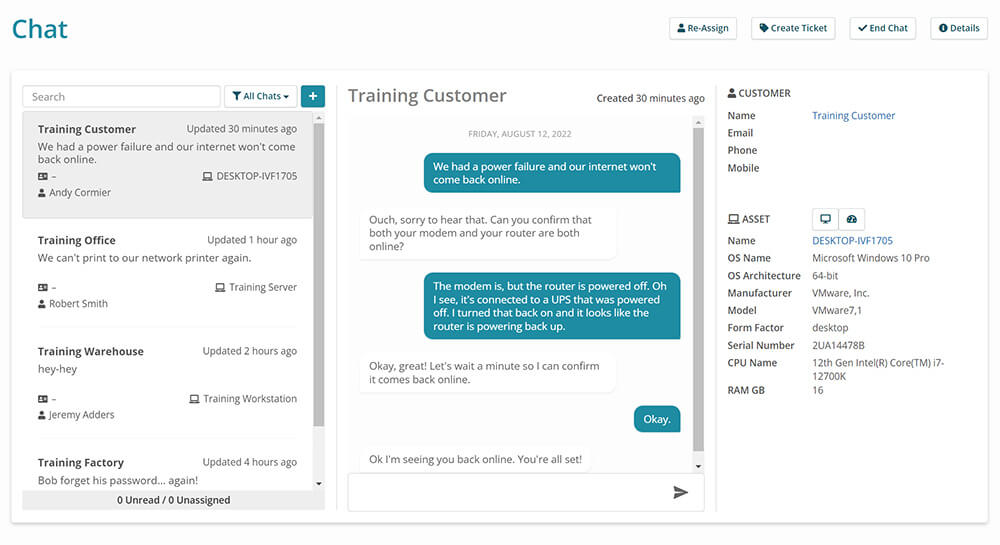
Features:
- Consolidated ticketing, invoicing, asset tracking, and endpoint monitoring.
- Scripting and scheduling options to automate OS and other software updates.
- Scripting engine and shared script library help create repeatable fixes.
- Splashtop app integration gives desktop access for remote client support.
- Modules for contracts, billing, and QuickBooks Online integration.
- Syncs appointments with Outlook, supports ticket-linked events, and tracks employee time.
Pros
Per-technician licensing helps MSPs grow device counts without increasing cost.
Simple ticketing and device staging shorten the time to serve clients.
Scripts and policies cut repetitive patching and ticket handling.
Limited downtime keeps technicians from dealing with tool outages.
Frequent updates, new integrations, and webinars demonstrate ongoing product improvement.
Cons
Dated and less customizable navigation than newer RMMs.
Internal reporting, technician metrics, and ticket data lack depth for advanced analysis.
Limited functionality for mobile apps.
Remote access heavily dependent on Splashtop integration, which some find unreliable due to lag and connection problems.
6. SuperOps
SuperOps is a cloud-first RMM and PSA platform built for small and midsize MSPs. It differentiates itself by lowering the entry barrier with a flexible subscription model and a clean interface that’s easy to learn. However, it still has some catching up to do in terms of features to be on par with the best NinjaOne alternatives in 2026.
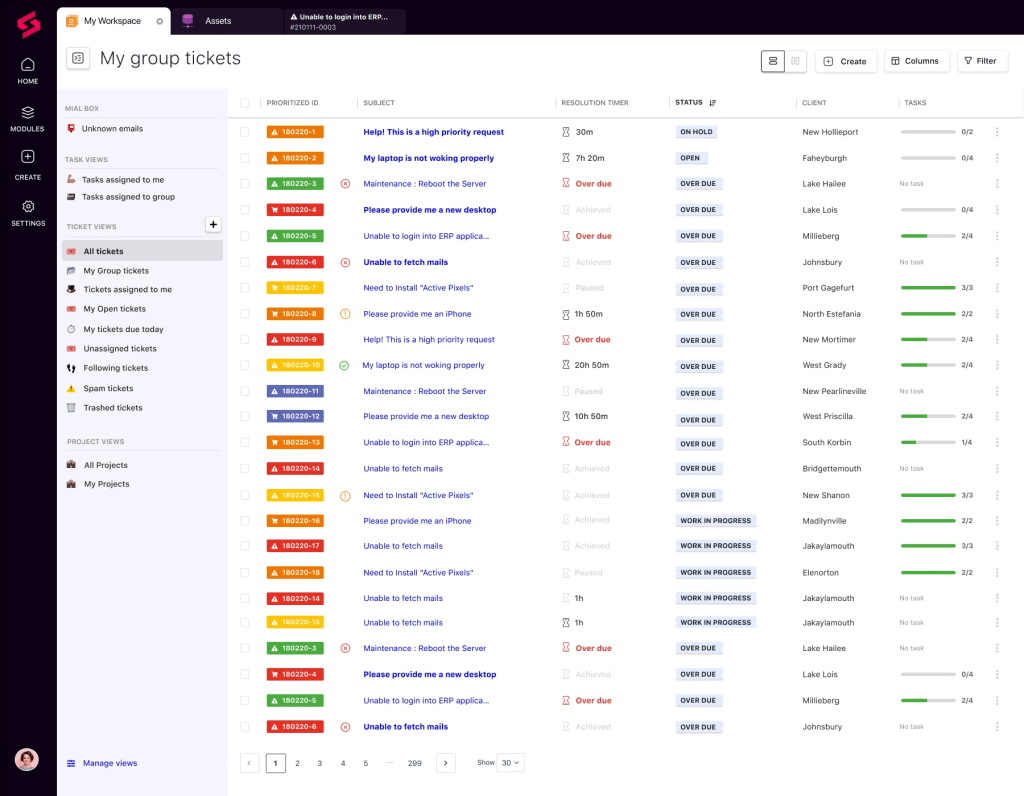
Features:
- Automated patch management across devices.
- IT asset monitoring across client environments.
- Built-in PSA tracks issues, links tasks, and logs technician time.
- Script library and customizable automation.
- Remote access to devices via Splashtop integration.
Pros
Clean, tab-based design and shallow learning curve make it viable for small MSPs.
Flexible pricing models allow businesses to subscribe separately to the PSA or RMM functionality.
Runbooks, timers for tickets, and easy search functions simplify technical workflows.
SuperOps development team acts on customer feedback and pushes updates quickly.
Cons
Lacks advanced capabilities, such as granular patch approval and historical trend reporting.
Limited native third-party integrations.
Occasional glitches with ticket updates, limited workflow automation, and lacks some important features, like auto-reply.
Configuration can require months before it’s fully usable.
7. Jira Service Management
Atlassian’s Jira Service Management is an IT service management (ITSM) platform designed to help IT teams resolve incidents, manage service requests, and oversee change management processes. It works best when IT, support, and product teams need one place tied to Jira Software and Confluence.
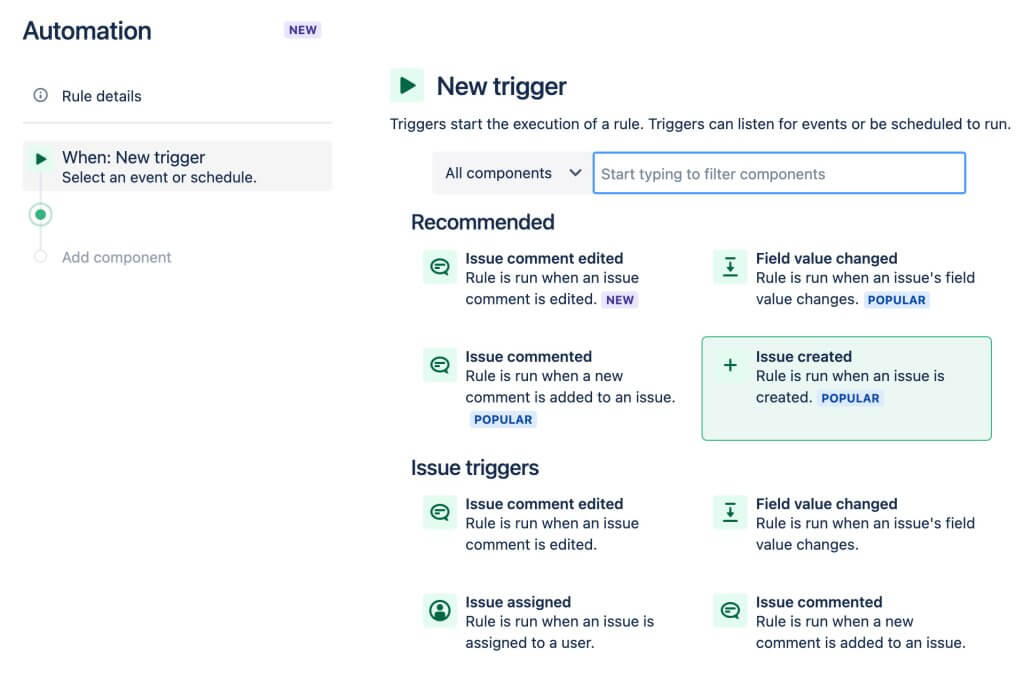
Features:
- ITIL modules for incidents, problems, changes, and requests.
- Visual workflow builder for approvals, SLAs, and automation.
- Integrations with Jira Software, Bitbucket, Slack, and monitoring tools.
- Asset and service mapping for ownership and dependency views.
Pros
Provides dashboards, ticket histories, and SLA compliance metrics for performance tracking.
Self-service and knowledge base deflect common requests before they reach agents.
Tiered pricing is suitable for any team and can grow with business needs.
Cons
Setup and customization can overwhelm new administrators and teams unfamiliar with Jira terminology.
Large ticket volumes or heavy filtering can slow the system.
Many advanced functions, such as advanced automation and reporting, require higher-priced plans.
8. Autotask
Datto’s Autotask is a PSA for MSPs that ties service delivery to contracts, time, and billing. In contrast to many of NinjaOne’s competitors for remote monitoring and management, Autotask is more of a full business management platform, focused on workflow automation and service desk functions.

Features:
- Rich ticketing functionality with customizable workflows, SLA tracking, and visibility into recurring issues.
- Automates repetitive actions such as ticket routing, queue changes, and client notifications.
- Tracks technician hours for each ticket or project and generates accurate client invoices.
- Integrates with Datto’s RMM tool for device monitoring, remote access, and automated troubleshooting.
Pros
Gives MSPs strong control over tracking and resolving client issues.
Customizable, real-time dashboards provide clear visibility into SLA compliance, task prioritization, and technician performance.
Customer portal centralizes all conversations and ticket updates.
Cons
Design feels dated and unintuitive, creating a steep learning curve for new users.
Large ticket volumes and data-heavy reports slow the system.
Lacks advanced CRM and mobile app support features.
Licensing and advanced AI features (like Cooper Copilot) are expensive, compared to alternatives.
9. Freshservice
Freshservice is a cloud-based ITSM with simplified incident handling, service requests, and asset tracking that offers ITIL-ready processes out of the box. And if you choose a plan with three or fewer agents, it’s a free NinjaOne alternative if you choose a plan with up to three agents.

Features:
- Freddy AI Copilot (AI-driven assistant) generates ticket summaries, suggests responses, and automates repetitive helpdesk tasks.
- Built-in SLA tracking and management modules send alerts before violations occur.
- Tracks IT assets from procurement through disposal, with visibility into device status and ownership.
- Self-service portal and knowledge base allow employees to find answers and resolve common issues.
Pros
Modern interface with straightforward ticket handling reduces training time for agents and resolution time for end users.
Workflow rules, AI-powered classification, and automated incident follow-up reduce manual effort.
Extensive integration with communication tools and orchestration servers to support both IT operations and business teams.
Free plan available for up to three agents.
Cons
Analytics and customizable reporting options are too basic for large enterprises.
Setting up tailored workflows and automations is time intensive and requires technical expertise.
Mobile functionality can lag and lacks the smoothness of the functionality for desktops.
Advanced features and premium plans cost more.
10. Lansweeper
Lansweeper is a network inventory and ITSM platform with modern ticketing, clear service catalogs, remote monitoring, end-to-end management, and task automation. Like Freshservice, this NinjaOne alternative has a feature-limited free plan.
Features:
- Single source of truth for IT, OT, and IoT assets across the organization helps identify hidden devices, track asset lifecycles, and detect vulnerabilities.
- Monitors assets from procurement through decommissioning.
- Custom workflows
- Alerts for changes in topology, failed scans, and device health anomalies.
- SQL-driven reports and visual dashboards with detailed insights.
Pros
Nearly unmatched visibility for IT, OT, and IoT environments.
Simplified deployment across infrastructure that doesn’t require installation on every device.
Custom automation, third-party tool connections, and extended workflows through API access.
Competitive cost compared to major IT asset management vendors, with flexible licensing based on asset volume.
Cons
Lacks deep analytics, but can export data to other BI tools.
Creating advanced reports often requires SQL expertise, which can be a barrier for nontechnical teams.
An unintuitive admin panel can overwhelm first-time users.
AReporting and scan functions may lag on large datasets and virtual machine environments.
Quick Comparison Table – Best NinjaOne Alternatives
The following table helps compare NinjaOne vs competitors with similar use cases and features.
| Tool name | Best for | Key features | Starting price |
| NinjaOne | SMBs and MSPs that need simple RMM |
|
Quote-based with a free trial |
| ConnectWise Automate | MSPs that need deep scripting |
|
Quote-based with a free trial |
| Ivanti Neurons (UEM) | Enterprises requiring strict compliance |
|
Quote-based |
| SolarWinds | Ops teams prioritizing uptime and ITIL |
|
$39 monthly per agent; free trial |
| ManageEngine Endpoint Central | Mixed OS fleets and budget control |
|
$104 monthly per agent |
| Syncro | MSPs preferring per-tech pricing |
|
$129 monthly per agent |
| SuperOps | Newer MSPs that want a simplified setup |
|
$79 (PSA only) or $129 monthly (PSA and RMM) per agent |
| Jira Service Management | ITSM with Dev/IT collaboration |
|
$19 monthly per agent; free plan for up to 3 agents |
| Autotask | MSPs linking tickets to billing |
|
Quote-based plans |
| Freshservice | Teams wanting easy ITSM and AI-enhanced tools |
|
$19 monthly per agent |
| Lansweeper | Asset discovery across IT, OT, and IoT |
|
$199 monthly per agent; free tier |
How to Choose from the Best NinjaOne Competitors
The following checklist of steps, combined with the descriptions above, can help you shortlist the RMM platforms that best fit your needs.
- Decide which software category you need. Decide whether you need a solution for RMM, ITSM, or something else.
- Audit your portfolio of devices and applications. Separately list special cases such as Linux graphical desktop control, Apple Silicon depth, Linux on ARM, and headless or kiosk devices (some NinjaOne competitors don’t support all of them).
- Determine necessary features. For example, if you need an RMM solution, consider whether you want session recording, consent prompts, clipboard controls, credential injection, or one-click launch from the device record.
- Review script and automation capabilities. Check parameter handling, secret storage, approval gates, event triggers, and how the product works with your version control process (to reuse scripts at scale).
- Compare per endpoint, per user, and tiered pricing plans. Factor in the cost of remote access add-ons, storage, premium analytics, and other add-on services. Consider asking for a three-year quote with clear minimums and overage fees.
- Review security and compliance features. Ensure the platform offers basic cybersecurity mechanisms (multifactor authentication, role-based access control, audit logs, session recording, etc.), with tight compliance controls for heavily regulated industries.
- Evaluate onboarding support. Check whether the provider assists with implementation and whether the platform itself offers training modules and extensive documentation.
- Consider ease of use and ramp-up time. During testing, track how many actions different teams must take to perform the most common tasks.
Check review platforms (like G2 and Capterra) for feedback from teams with a similar size to yours. Pay attention to recurring complaints and praise, particularly for support, onboarding, and cost.
Final Thoughts
Our guide will help you understand which NinjaOne alternatives are most recommended, and which one should fit your company. However, once you pick a replacement, you will likely need to migrate your help desk data.
Help Desk Migration can handle the help desk migration process, while minimizing risk and preserving ticket history and user relationships, so your new RMM and PSA platform is ready from day one.
Frequently Asked Questions
NinjaOne doesn’t offer a permanent free version, but you can start with a free trial to explore its features before committing.
In many cases, yes. NinjaOne can replace Intune for endpoint management, patching, and monitoring. However, Intune may still be preferred if your needs are heavily tied to Microsoft 365.
The best RMM tool depends on your business size and IT needs. NinjaOne is consistently ranked among the top choices thanks to its ease of use, automation, and strong customer support.
No, NinjaOne doesn’t include a built-in PSA. Instead, it integrates with popular PSA platforms so you can connect RMM with billing, project management, and service workflows.
NinjaOne is a full remote monitoring and management (RMM) platform designed for IT teams and MSPs. Scalefusion, on the other hand, is mainly a mobile device management (MDM) solution focused on smartphones, tablets, and rugged devices.
Not exactly. NinjaOne is primarily an RMM solution, but with its ticketing system and integrations, it covers some IT service management (ITSM) functions. For full ITSM capabilities, you may need a dedicated ITSM platform.
NinjaOne includes a built-in ticketing system that helps IT teams capture, track, and resolve support requests without needing a separate tool.
Yes, NinjaOne tracks device activity, performance, and user sessions. These insights help IT teams monitor systems, troubleshoot issues, and ensure compliance.



